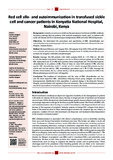| dc.description.abstract | Background: Currently, no data are available on the prevalence of red blood cell (RBC) antibody formation amongst Kenyan patients with multiple transfusion needs, such as patients with sickle cell disease (SCD) or haematological malignancies (HM) and solid (SM) malignancies.
Objectives: We determined the prevalence and specificities of RBC alloantibodies and autoantibodies in two patient groups with recurrent transfusion demands at Kenyatta National Hospital, Nairobi, Kenya.
Method: Between February and August 2014, 300 samples from SCD, HM and SM patients were collected and screened for alloantibodies. Samples from 51 healthy blood donors were screened for irregular antibodies and phenotyped.
Results: Amongst the 228 patients with viable samples (SCD, n = 137; HM, n = 48; SM, n = 43), the median transfusion frequency was two to three events per group, 38 (16.7%) were RBC immunised and 32 (14.0%) had a positive direct antiglobulin test. We identified specific alloantibodies in six patients (2.6%). Four of these six were SCD patients (2.9%) who had specific RBC alloantibodies (anti-Cw, anti-M, anti-Cob, anti-S); amongst HM patients one had anti-K and one had anti-Lea. RBC autoantibody prevalence was 3.1% (7/228). Amongst the healthy blood donors, the Ror, ccD.ee and R2r, ccD.Ee phenotypes accounted for 82% of the Rhesus phenotypes and all were Kell negative.
Conclusion: The numbers of transfusions and the rates of RBC alloantibodies are low and the most important RBC alloantibody-inducing blood group antigens are relatively homogeneously distributed in this population. A general change in the Kenyatta National Hospital pre-transfusion test regimen is thus not necessary. The current transfusion practice should be reconsidered if transfusion frequencies increase in the future. | en_US |



